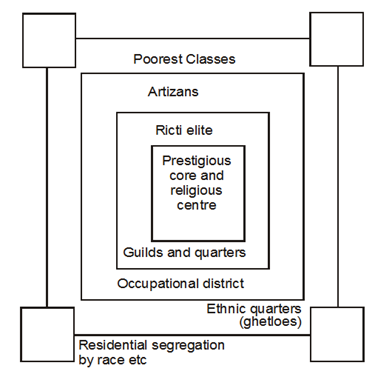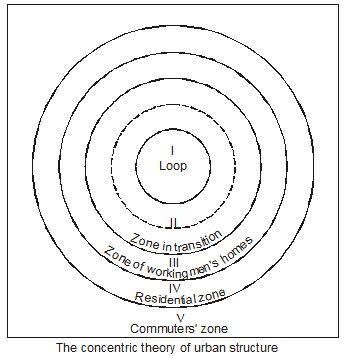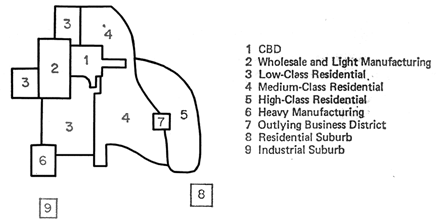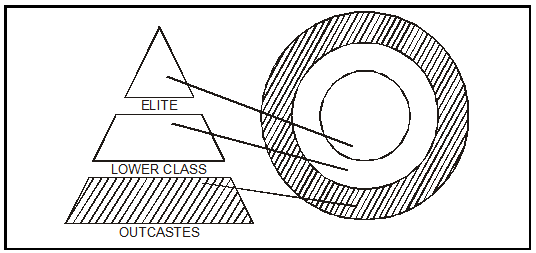
Engage with specialized UPSC Geography Optional Mains Topic Wise Questions centered on Population and Settlement Geography. Delve into the intricate dynamics of human populations and their spatial distribution, essential for UPSC mains preparation. Each question is meticulously tailored to deepen comprehension and analytical skills, covering a spectrum of demographic patterns, migration trends, and settlement dynamics. From urbanization to rural-urban migration, aspirants gain profound insights into the complexities of population geography. With detailed explanations and structured content, this resource serves as an invaluable aid for mastering population and settlement geography principles, crucial for success in the UPSC examination. Whether you’re a newcomer or seasoned aspirant, immerse yourself in Population and Settlement Geography to enrich your UPSC Geography Optional Mains journey and excel in your examination preparations.
Contents
- 1 Q1. Slums and squatter settlements. (1994)
- 2 Q2. Delineation of Urban fringe. (2007)
- 3 Q3. Concept of primate city (2005)
- 4 Q4. Bring out the contrast between the internal structure of the pre-industrial and industrial cities. (1999)
- 5 Q5. Discuss the major international streams of migration in the world in recent times and account for the relationship that exists between population pressure areas and migration prospects. (1995)
- 6 In case you still have your doubts, contact us on 9811333901.
Q1. Slums and squatter settlements. (1994)
Answer:
A slum denotes a residential area where the dwellings by reason of dilapidation, over crowding , faulty arrangement of design, lack of ventilation, light and sanitary facilities or any combination of factors are detrimental to safety, health and morals. According to the estimates of Town and Country Planning Organization, about 21.2% of India’s urban population lives in slums. This proportion is even higher in metropolitan cities like Kolkata, Mumbai, etc.
The origin and development of slums and squatter settlement is the result of many causes and processes. First of all, the growth rate of urban population is higher than the countryside, especially in the developing countries.
The rural-urban migration contributes significantly to the higher growth rate of population. Several push factors such as poverty, unemployment and lack of other amenities exist in the rural areas of developing countries due to which people migrate to towns and cities. On the Other hand, dense population pressure exists in the cities of developed countries due to many pull factors in the form of civic amenities.
However, the growth of civic amenities in the urban areas does not keep pace with the housing facilities. Poor people are not able to pay high rent of houses in the towns. Hence, wherever they find a land, public or private, they start living there in temporary dwellings. Later on, this place develops into a slum or squatter settlement.
In some places the old areas of the cities, due to their dilapidated houses, uncontrolled growth, over crowding and lack of space, get converted into slums, e.g. the area around Jama Masjid and Chandni Chowk in Delhi.
Such is the pace of growth of slums that slum-dwellers inevitably outnumber the new homes provided by city housing authorities. This is sometimes true even in the cities of advanced countries where the old tenements and worker’s dwellings, often in the congested heart of the cities, are in slum conditions. But such is the shortage of land that new homes can’t be built until the slums have been cleared. Thus, almost everywhere progress to improve conditions is very slow.
However, following measures are suggested to overcome the problem of slums:
- Looking after the source regions of slums in developing countries, i.e. rural development so that rural-urban migration can be reduced.
- Employment generation in small towns also which would lead to well-distributed urban growth.
- Urban planning for the entire city region and hinter land.
- Complimentarity and integration between urban planning and regional planning.
- Re-development of existing slums.
- A long term policy for planned and regulated growth of towns and cities.
Q2. Delineation of Urban fringe. (2007)
Answer:
The term rural-urban fringe has been used to designate a zone of discontinuity between city and country in which rural and urban land-uses are mixed. The absence of a clear break between rural and urban conditions is a feature of the modern city. The rural-urban fringe can be viewed as an area of invasion in which population density is increasing rapidly and land values are rising.
Rural-urban fringe has been a characteristic feature of western cities, though it is a recent phenomenon in India. It was only with accelerated rural-urban migration after independence that the rural-urban fringe became a common feature of big cities. The characteristic haphazard urban growth, in course of time, has transformed the villages lying close to cities into a semi-urban settlement.
An inner fringe (sometimes called urban fringe) is characterized by land in an advanced stage of transition from rural to urban land uses like,
- small or large factories.
- land used for warehouse, bus & truck repairs etc.
- rows of shops from the village leading to the city,
- institutions such as colleges, hospitals etc.
- waterworks, sewage plants, burial grounds etc.
In the outer fringe (sometimes called rural fringe), the rural land uses continue to dominate but the infiltration of urban elements is clear, such as,
- commercial cropping pattern like fruits, vegetables, flower gardens and dairying having high demand in cities,
- the employment pattern, at least some adults regularly commute to the city for work,
- strong linkages with the city.
However, it is not easy to demarcate a rural-urban fringe. Following are some of the important indicators generally taken for the delimitation of rural-urban fringe:
- Density of Population,
- Population Growth,
- Male-female Ratio,
- Proportion of workers in non-agricultural activities, and
- The outer limit of city bus service
Problems of rural-urban fringe: The fringe areas offer a great challenge to the urban planners. It is an area of rapid change in land use and demographic structure. A major problem is that all obnoxious land uses relevant to the urban area are pushed towards the fringe areas such as garbage dumps, water works, burial and cremation grounds, brick kilns & so on. Polluting industries and slums are often relocated near fringe villages.The proper development and utilization of land in rural-urban fringe requires the preparation of a detailed plan for land use and its effective implementation. The plan must demacrate areas for residential, industrial & other public uses and provide for basic urban amenities. Problems of rural-urban fringe require urgent regulation.
Q3. Concept of primate city (2005)
Answer:
One of the earliest generalizations concerning the size distribution of cities is the concept of primate city given by M.Jefferson in 1939.
According to him, the primate city is a country’s leading city and is several times larger than the second ranking city. He believed that once a city is larger than the other it gets an advantage over the other cities to grow more rapidly with the help of large scale in-migration & it becomes primate city.
Factors Affecting Primacy:
A. Linsky demonstrated that countries with a high degree of primacy tend to display the following characteristics:
- small territorial extent
- relatively high population density
- low per capita income
- a high degree of dependence upon agricultural exports
- high rate of population growth
- in many cases a former colonial status
Barry and Horten (1970) added some more factors such as countries with commercialisation, superimposed on subsistence level agricultural system; small countries engaged in production of relatively few commodities, etc.
Applicability: Primacy is more frequently found in developing countries. However, it is not universally applicable, not even in all developing countries. Large size, long period of urbanisation and some historical and cultural factors may inhibit development of primacy such as in Canada, USA, India, etc.
Indian context: There is not primate city at the national level owing to:
- large size of the country
- weaknesses in the nationalism in the past
- partial-federal set up
The last factor, however, is mainly responsible for development of primacy in some of the states, e.g. West Bengal (Calcutta/Asansol = 25.08), Maharastra, Karnataka, North-East except Nagaland, etc. A trend towards lack of primacy in North Indian states, in general is ascribed to shadow effect of Kolkata and Delhi.
Q4. Bring out the contrast between the internal structure of the pre-industrial and industrial cities. (1999)
Answer:
G. Sjoberg in the his book ‘The pre-Industrial City’ has attempted to examine the structure of urban settlements both in Europe and elsewhere in the world prior to the impact of large scale industrialisation. In his work he has made generalisations about the form of society and urbanisation before the modern era. His pre-industrial city represents a stage in the evolution of the city, mainly the western one.
Pre-industrial cities are product of their societies and at that time societies were feudal, embodying a social stratification system with a small elite and a much larger lower class. The pre-industrial city was controlled by this elite which derived its power from non-economic, often from extra urban sources. Society at that time was also dependent on animate energy. Such cities were small with less than 50 thousand population and each city contained only a very small proportion of national population.
Pre-industrial cities were multi functional, performing largely military and political/military roles but with economic, religious, administrative, educational and cultural functions in a supportive role. This was reflected not only in the power structure but also in the urban morphology: the key feature was the compact form—a distinct urban nucleus bounded by walls, which served as defences and as means of controlling the city of migrants and traders.

The internal morphology was characterised by narrow streets and a lack of functional differentiation of land use, since with separation of work place and residence uncommon, most plots were put to multiple use. Sjoberg suggested a broad zonal pattern with the elite group residing close to the prestigious central core and the artisans and poor living in progressively less prestigious areas away from the core. Outside the central core some residential differentiation in the form of quarters could be distinguished on ethnic, occupational or kinship grounds.
The concept was criticised for the following reasons:
(1)a singly type of city is unlikely to have existed in all parts of the world, over a time span of more than thousand years;
(2)because of the use the term feudal to describe all societies before the Industrial Revolution; and
(3) not all such cities were unplanned and disorganised. In India Rajgir, Maduriai, Varanasi, Kanchipuram etc. are cited as examples of ancients cities.
Various generalisations have been made in the form of theories to understand internal structure and growth of cities. Although each city is unique, there is nevertheless a considerable degree of repetition in the broad geographical arrangement of the various categories of urban land use from one city to another. An analysis of following theories will throw light on the structural pattern of industrial cities.
I.The Concentric Zone: Propounded by Ernest Burgese in 1925, the theory envisaged the development of a city outwards from a centre in five concentric zones.

Zone I-The Central Business District (CBD
Zone II-Zone in transition with industrial premises
Zone III-Zone of workmen’s homes (Low income housing)
Zone IV-Residential zone of middle income group
Zone V-The high class residences (com muter’s zone) CBD is the marked feature of modern industrial cities which is located in the centre of the city having high concentration of commercial, social and civic amenities.
The model of Burgese was criticised for it makes insufficient reference to the siting of industry which rarely forms a continuous concentric zone and that the concentric zones are inevitably distorted by major transport axes and topographical features. Even in Western world, never smaller rapidly growing cities do not necessarily follow this pattern.
II.Sector Theory: Proposed by Himer Hoyt and M.R. Davie in 1939, the theory suggests that patterns of urban land use are conditioned by arrangement of routes radiating out from the city centre which create sectoral pattern of land and rental values which in turn influences urban land use patterns.
This idea of a wedge like expansion is an improvement on the earlier concentric model in that it takes into account both the distance and direction of expansion, and acknowledges the importance of transport routes on the growth of the cities.
III.The Multiple Nuclei Theory: The advantage of concentric and sector theories is their simplicity, but actual patterns of urban structure are far more complex and varied. In 1945 C.D. Harris and E.L. Ullman proposed the multiple nuclei theory which can be applied to a variety of urban patterns. They suggested that land use patterns in most large cities develop around a number of discrete centres or nuclei which results in a cellular structure. The theory suggests a number of general principles relevant to the land use pattern of most cities, both in developed and developing regions.

IV.The Social Area Analysis Model: This model incorporates all three aspects of city structure, namely concentric zones, sectors and multiple nuclei. Developed by R.A. Murdie in 1969, the model makes use of following social criteria:
(1)Family Status
(2)Economic Status
(3)Ethnic Status
According to this model, the physical space of streets, buildings and roads are superimposed by three dimension of social space, as shown in the figure below:

Industrial cities embody the main elements of these theories in varying degrees and in various combinations. In general the small towns (especially old towns on the plains) exhibit concentric zones, medium sized towns have sectors and large towns show a multiple nuclei pattern.
Q5. Discuss the major international streams of migration in the world in recent times and account for the relationship that exists between population pressure areas and migration prospects. (1995)
Answer:
Migration may be interpreted as spontaneous effort to achieve a better balance between population and resources. It is defined as a movement of population involving a change of permanent residence of substantial duration. It is a sensitive index of geographical analysis of population change and changing pattern of economic opportunities in any area.
Push Pull Theory: Last 50 years or so have seen a considerable degree of international migrations. Generally speaking inequalities of one kind or another are virtual preconditions of migrations. Such an idea underlines the ‘Push-Pull theory’.
‘Push’ factors are those influences which are thought to initiate migration flows-they are adverse conditions which cause a population to seek a living elsewhere- Low wages, poverty, famine, unemployment and natural disasters can be cited as such factors.
‘Pull’ factors are the attractions, real or imagined of destination areas such as- high waves, cheap availability of land attractive living conditions and opportunities of economic development.
Now let us analyse some of the specific reasons for such migrations:
Economic Motives: Economic Motives are dominant in international migrations availability of work is probably an important factors. In many under – developed and developing nations that are facing population – explosion the agricultural and industrial infrastructrue cannot absorb the surplus labour and it encourages migration. Examples-Indians or Pak migrating to Britain or Middle East and South Europeans to industrialised countries of Switzerland and Germany.
In many cases where government policies are favourable to foreign investors- big business houses set up their units leading to migration of both management and a part of workers. Many Indians have set up individual units in South-East and in Africa.
It is necessary to caution, that any migration flow must be interpreted as the aggregate result of numerous personal decisions about whether or not to move, where to move and when to move. Thus emphasis is being increasingly placed on the psychology of decision making.
Restrictions: Analysis of international migration simply in terms of economic motive is complicated by the many legal restrictions,social policies and political. barriers which impede the free movement of people on a world scale.
Religious Persecution: Religious Persecution where adherents of a particular religion are persecuted or where sects are not tolerated, people may move to places where they may safely practice their religion. Examples- Jewish migration to Israel after 1948 and huge transfer of population between India and Pak in 1947.
Political Persecution: People migrate to avoid pol persecution or due to dissatisfaction which the form of government in their own country. Examples-There has been a steady flow of refugess from the communist countries esp. to west Germany (former), S.Korea and Hongkong. The Mujahideen refugees from Afghanistan have migrated to Pak in the early 80s due to their opposition by the present government.
Wars: Wars cause a great no. of people to migrate. People flee before an advancing army to avoid subjection to a new regime. Out migration from Occdupid territories in Israel (West Bank, Gaza & Golan Heights) and that from Iraq during and after ‘Operation Desertstorm can be cited as examples.
Sometimes major population movements are effected by force not to the benefit of migrants. Racial religious or pol. groups may be forced to leave. Eg. expulsionof Asian from Ugenda in 1972, Chinese from Vietnam (Boat people), Muslims from Myanmar (Rohingyas). Bangladeshis from Chittagaong (Chakmas) and Tamilians from Sri Lanka.
Deportation of Criminals: Another form of forced migration is deportation of criminals. Till recently European criminals were deported to British colonies overseas. Prisoners in erstwhile Russia went sent to Siberia.
New Trends: In the contemporary world, there is an overwhelming tendency for the better educated, more skilled and economic better off to migrate. Skilled labour moves to find better salaries and jobs even though they could be employed at home. e.g.- the migration of Asian doctors and nurses to Britain and the migration of British doctors and nurses to the US. This type of migration is often reffered to as ‘Brain Drain’.
Consequences: Now let us discuss the Socio-economic and political consequences of these migrations:
Demographic: Demographic consequences-International migration cause change in the total number and distribution of population as also changes in the population-resource relationship of the two areas involved.
Sending areas become depleted of young adults, while receiveing areas show a high proportion of population in this age group. Migration results in a change in almost all the attributes of population such as numbers, density, age sex-ratio, growth, mortality etc. In earlier times international and long distance migration showed a marked predominance of males thus creating serious imbalance in sex-ratio of both the sending and the receiving areas. For e.g. in the US in 1910 at the period of maximum immigration there were 106 males/100females.
Economic: Economic Consequences- any assessment of economic consequence of migration must take into account the age, health, occupational skills and educational attainment of the immigrants, together with the economic needs of receiving country and its ability to absorb increased number.
In the sending areas the loss of a large no of people by emigration can cause the ageing of the population, loss of most vigorous section of population and slowing down of resource development. On the other hand, in small areas of extreme population pressure, the loss of population may be beneficial and may lead to rise in the living std. In the destination country a large no. of immigrants may either be burden or stimulus to development.
Social Consequences: In many parts of the world problems of race, language and region have their orgins in an earlier pattern of migration. Migration results in the genesis of pluralistic societies by bringing different races, language groups and religious communities into contact and conflict. First generation immigrants lead to settle in urban environments and to establish themselves in national and religious groups thus forming urban ‘ghettoes’ often overcrowded and with consequent social problems. Pluralistic societies generate continuning source of friction. We have for eg. the case of Africanrs and the Whites in S.Africa and the French and the British in Canada.
Multiplicity of Language: In an area makes communication difficult. There is also the gradual penetration of some word of a language into the vocabulary of the other.
Religious differences are a source of conflict, for instance between the Chinese and the Muslims in Indonesia & Malaysia or between Christians and Muslims in Philippines. It is also difficult to keep a balance in the economic development of different racial and cultural groups the economic dominance of the Chinese immigrants in Malaysia is unwelcome to indigenous peoples which leads to constant tension similarly native Fijians oppose dominance of Indian immigrants in trade, agri & commerce.
The plurality of society in terms of different racial, linguistic and religious groups is great hindrance in establishing national unity. This leads to political instability in many countries, with each group clamouring for the right to national self-determination.
Cultural Consequences: Taking a more optimistic view, despite the problems, migration is a vital process in the exchange of ideas between different cultures and the diffusion of knowledge in the complex web of civilisation. Each migrant by nature seeks to create something of the original milieu in the midst of his new environment and thus enriches the civilisation.
Case Study: A case study was conducted in South-East Asia with following findings:
- Development of commercial agriculture implied conflicts over land and resentment amongst traditional societies at changes in their way of life.
- Encouragement of immigration particularly of Chinese workers led to the establishment of a large alien minorities in many South East Asian countries.
- The introduction of christianity added to the already enormous range of religions in the area.
- Use of European languages for education and administration implied that the post independence movement towards the establishment of a national language was rendered difficult.
- Cultural individuality of various European powers was impressed on South East Asian countries which got reflected in administration forms of government, education system, planning and appearance of towns and cities.
In case you still have your doubts, contact us on 9811333901.
For UPSC Prelims Resources, Click here
For Daily Updates and Study Material:
Join our Telegram Channel – Edukemy for IAS
- 1. Learn through Videos – here
- 2. Be Exam Ready by Practicing Daily MCQs – here
- 3. Daily Newsletter – Get all your Current Affairs Covered – here
- 4. Mains Answer Writing Practice – here

